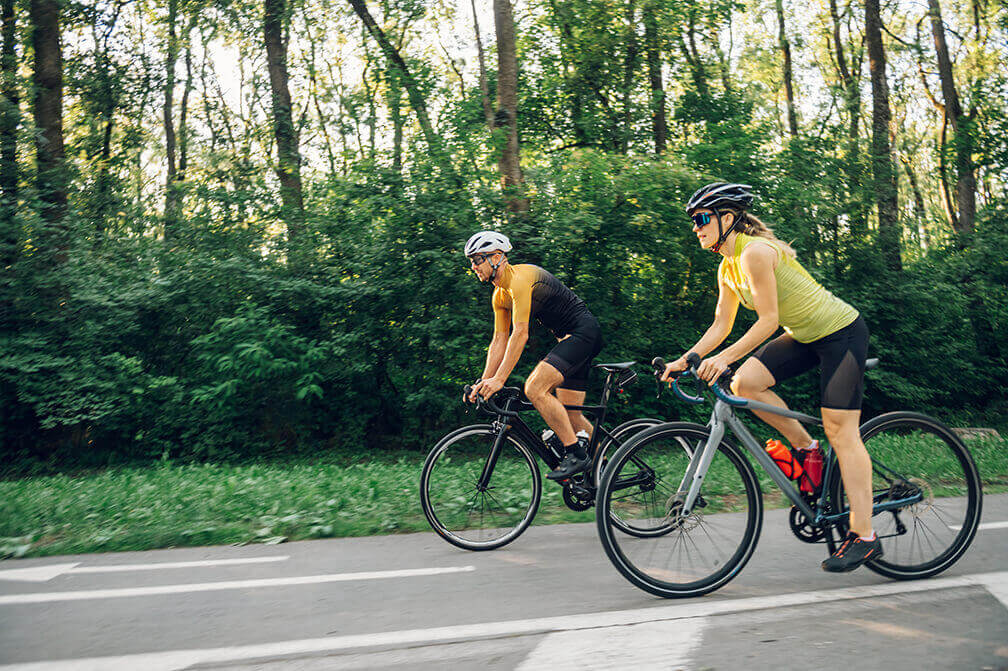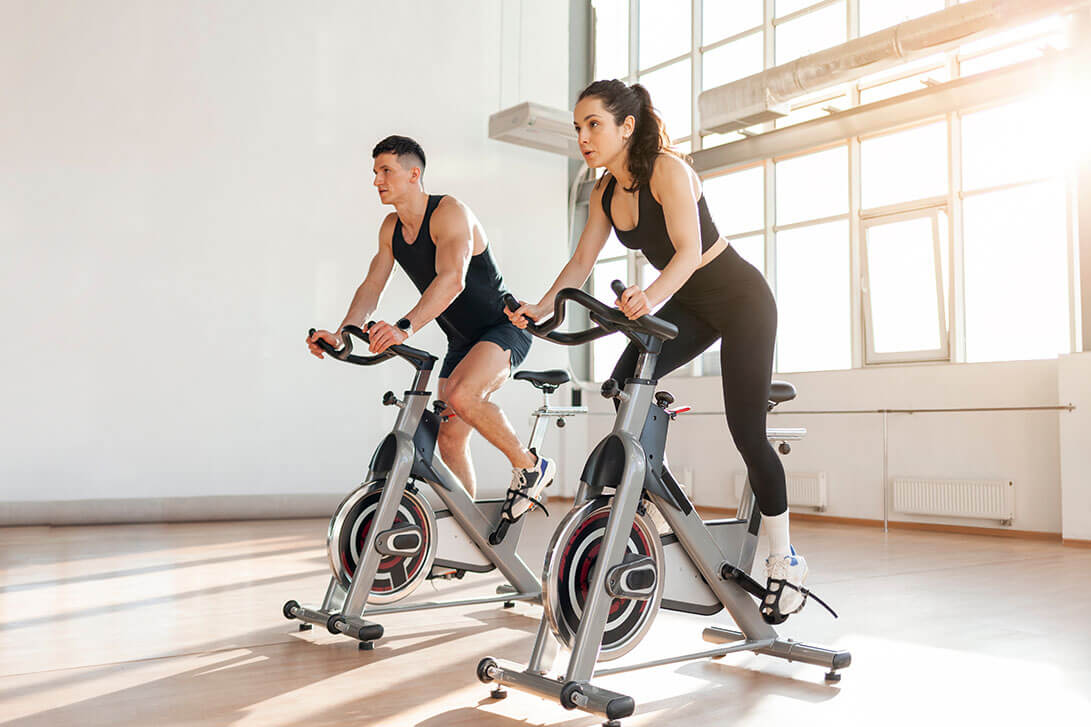Welcome to the thrilling world of road cycling! Whether you’re just starting or looking to advance your skills, this comprehensive guide has got you covered. From selecting the perfect road bike to mastering essential cycling skills, we’ll help you navigate the exciting journey to becoming a confident road cyclist. So buckle up and let’s dive into the exhilarating world of road cycling together!
Key Takeaways
- Experience the thrill of road cycling with the right equipment and techniques!
- Get a professional bike fit, choose your frame material & equip yourself with essential gear for safety & comfort.
- Master basic skills like shifting gears, braking techniques and ride safely to take your riding experience to new heights!
The Fundamentals of Road Cycling

Road cycling is an exhilarating form of exercise and transportation that caters to various levels of enthusiasts, from recreational riders to professional racers. Embarking on this amazing journey entails understanding the diverse types of road cycling, including:
- Circuit races
- Road races
- Stage races
- Criterium racing
- Iconic events like the Tour de France and Grand Tours
Investing in the correct equipment and mastering necessary techniques is pivotal to thoroughly relishing your road cycling experience. From selecting the perfect road bike and helmet to mastering shifting gears and braking techniques, every aspect plays a vital role in ensuring a safe and enjoyable ride. And it doesn’t end there! Wearing the right road bike shoes can significantly improve your performance, especially in competitive events like stage races and team time trials.
Exciting formats such as:
- Mass start events
- Time trials
- Handicaps
- Individual time trials
Road cycling competitions. Each format brings unique challenges and requires specific skills and tactics to excel. So buckle up, and let’s explore the exhilarating world of road cycling together!
Choosing Your First Road Bike

Embarking on your road cycling journey begins with choosing the right road bike. Road bikes typically feature drop-bar handlebars and skinny 700c wheels for a lightweight and efficient ride. As a beginner, it’s wise to start with a bike that’s already on hand or can be borrowed or rented, whether it’s a road bike or a mountain bike. This way, you can experience how cyclists ride and decide if road cycling is for you.
Several factors affect your choice of bike: how you intend to ride it (recreationally, competitively, or for commuting), your budget, and the availability of bike lanes in your area. It’s highly recommended that cyclists of all levels get a professional bike fit, especially if you plan to participate in stage races or other competitive events. Moreover, having the right bike size and handlebar setup can make you comfortable, powerful, and happy while cycling.
Road bikes come with two types of brakes: rim brakes and disc brakes, including the rear brake. Rim brakes stop the bike by exerting pinch pressure on the rims of the wheels, while disc brakes do so by exerting pinch pressure on a disc attached to the wheel hubs. Disc brakes tend to work faster, especially in wet weather, providing an advantage in team time trials and other competitive events. Ultimately, your choice of brakes depends on your preferences and the type of riding you plan to do.
Frame Material Choices
In the realm of road bikes, the performance and feel of the bike heavily depend on the frame material. The most common frame materials are:
- Steel: strong and durable, but heavier than other materials
- Aluminum: lighter and rust-free, making them a popular choice among cyclists
- Titanium: lightweight and strong, providing a smooth ride
- Carbon fiber: extremely lightweight and stiff, offering excellent power transfer
Each material has its unique advantages and disadvantages, allowing cyclists to choose the frame material that best suits their needs.
Titanium frames are incredibly lighter but just as strong as steel, while carbon fiber is known for its lightweight and stiff properties, providing a smooth and responsive ride. Lighter frames offer better acceleration and climbing, requiring less effort to pedal.
When choosing a frame material, consider your riding style, preferences, and budget to find the perfect match.
Sizing and Fit
Securing the right bike size and fit is pivotal for achieving comfort and superior performance. Bikes come in a variety of frame sizes. This assists you to choose the right bike that is best suited for your height and inseam length.
To find the right bike frame size, follow these steps:
- Measure your height and inseam.
- Compare your inseam to the standover height listed for the bike.
- Ensure a proper fit by selecting a bike with a standover height that is slightly lower than your inseam measurement.
By following these steps, you can ensure that you choose the right bike size and achieve a comfortable and proper fit.
When straddling the top tube of your bike, aim for an exciting one inch of clearance between your body and the top tube.
A professional bike fitting can greatly enhance your overall cycling experience, ensuring that your bike is tailored to your body and riding style.
Essential Road Cycling Gear

Adorning yourself with fundamental road cycling gear greatly boosts your safety and comfort during rides. The most crucial piece of gear for any road cyclist is a helmet. In addition to helmets, proper cycling clothing, such as jerseys and padded shorts, is designed to improve aerodynamics and rider comfort. Footwear is also important, with road bike shoes providing a secure connection to the pedals for better power transfer.
The importance of proper gear extends beyond comfort and functionality to safety. Some essential gear for cyclists includes:
- Cycling sunglasses, which protect your eyes from bugs, stones, sun, and rain
- Wireless charging phone case and phone mount to securely mount your phone to your handlebars and charge it
- A good lock, which keeps your bike secure from theft
- Accessories like lights and reflectors, which increase your visibility to other road users, especially in low light conditions
Maintenance tools, such as a pump compatible with your tire valves (Presta or Schrader), are essential for on-the-go repairs and adjustments. A GPS-style bike computer can help you plan and track rides, and even compete with other riders who post their routes online. Equipping yourself with the right gear and tools ensures a more enjoyable and safer road cycling experience.
Helmet Selection

Selecting an appropriate helmet for road cycling plays a significant role in ensuring your safety and comfort. All bicycle helmets in the United States must meet established safety standards, so you can trust that your helmet will provide the necessary protection. Look for helmets with the following features:
- Ventilation
- Absorbent pads for moisture control
- An adjustable dial for a snug fit
- An easily adjustable chin strap
Some helmets also incorporate advanced safety technologies like MIPS (Multidirectional Impact Protection System). MIPS uses two layers in the helmet to help the head rotate slightly on impact, reducing the rotational forces during a crash and potentially preventing brain injuries and concussions.
When choosing a helmet, consider the fit, ventilation, and any additional safety features to ensure the best protection possible.
Apparel and Footwear
Choosing suitable road cycling apparel and footwear is vital for enhancing comfort, functionality, and visibility during rides. Padded bicycle shorts provide cushioning between the rider and the saddle, reducing the likelihood of chafing and saddle sores. Cycling jerseys, made of synthetic fabrics like lycra, offer a close fit, bright colors, and pockets on the back for easy access to essentials during rides.
Proper road cycling gear includes:
- Road cycling shoes with rigid soles and a secure connection to clipless pedals to optimize power transfer and reduce the chance of cramping and pain
- Full-fingered gloves and overshoes for riding in cold weather to provide additional warmth and protection
- Cycling sunglasses with interchangeable lenses to shield your eyes from the elements.
Investing in the right apparel and footwear ensures a more comfortable and enjoyable road cycling experience.
Must Have Accessories
Adding essential items to your road cycling gear can boost your safety, comfort, and the overall enjoyment of your ride. Lights and reflectors are crucial for increasing your visibility to other cyclists and motorists, especially in low light conditions or bad weather. A mirror attached to your bike helps you see traffic approaching from behind without turning your head. A phone mount will allow you to keep your phone securely mounted to your bike and within view on your rides. When searching for a phone mount, find one that offers wireless charging, so you won't have your phone battery die mid ride.
For basic maintenance and on-the-go repairs, carry the following items:
- Tire lever
- Patch kit
- Pump compatible with your tire valves (Presta or Schrader)
- Spare tube
- Multi-tool
These tools can come in handy during emergency repairs.
When selecting accessories, consider your riding conditions, budget, and personal preferences to make the best choices for your needs.
Pedals and Saddles
Your road cycling experience is largely influenced by the pedals and saddles you use. Choosing the right ones can greatly impact your comfort, efficiency, and overall enjoyment of the ride. Clipless pedals, a shoe-pedal combination that offers amazing control, dramatically improve pedaling efficiency by keeping your feet from flexing and optimizing the transfer of energy to the pedals.
Proper saddle fit is essential for maximum comfort during long rides. Different riders have varying preferences when it comes to saddle design and materials, so take the time to find the one that suits you best. To prevent flat tires, ensure your tires are properly inflated and inspect them regularly for damage or punctures. Knowing how to fix a flat tire is also crucial in case of emergencies.
Investing in the right pedals and saddles tailored to your preferences and riding style can make a world of difference in your road cycling experience. From comfort to performance, these components play a vital role in ensuring that you enjoy every mile on your bike.
Basic Road Cycling Skills

Acquiring fundamental road cycling skills is vital to ensure efficient and safe rides. From shifting gears to braking techniques, these skills form the foundation for a successful road cycling journey. Practice makes perfect, so take the time to familiarize yourself with your bike’s components and how they function during rides.
Shifting gears on a road bike can be a bit tricky at first, but with practice, you’ll learn how to make smooth transitions and avoid common issues such as cross-chaining. Proper braking techniques are also crucial for maintaining control during descents and turns, as well as ensuring your safety on the road. By mastering these essential skills, you’ll be well on your way to becoming a confident road cyclist.
In addition to gear shifting and braking, work on other important cycling skills such as cornering, drafting, and descending. These techniques will not only enhance your overall cycling abilities, but also help you ride more efficiently and safely in various road conditions and situations.
Shifting Gears
Comprehending and perfecting gear shifting on a road bike is key to having efficient and pleasurable rides. Here are some tips for shifting gears smoothly.
- Pedal while shifting
- Use only one shifter at a time
- Avoid cross-chaining, which occurs when the chain is on the largest chainring and largest cassette cog or the smallest chainring and smallest cassette cog.
With practice, you’ll learn how to anticipate terrain changes and shift gears accordingly to maintain a consistent cadence and avoid putting too much strain on your legs. Proper gear shifting allows you to tackle hills, headwinds, and other challenges with ease, making your rides more enjoyable and efficient.
Braking Techniques
Maintaining control and safety during road cycling requires the application of proper braking techniques. Apply both brakes at the same time, gently at first and then increasing the pressure as needed, to ensure smooth and controlled stops. To maintain a safe speed while descending, use the brakes intermittently - gently pressing and releasing them. This action is better described as feathering rather than holding the brakes down continuously.
By mastering effective braking techniques, you’ll be able to navigate turns, descents, and other road situations with confidence and control. Remember, practice makes perfect, so spend time familiarizing yourself with your bike’s left brake lever and how it responds in various conditions.
Riding Safely on the Road
Though road cycling is invigorating, it bears certain risks. Adherence to a few fundamental guidelines is crucial for your safety and the safety of others on the road. Here are some important tips to follow.
- Always obey traffic laws.
- Stay as far right as practical.
- Move into the left-hand lane when making a left turn.
- Ride single file when riding with friends.
- Be mindful of your surroundings and anticipate potential hazards, such as potholes, debris, or other road users.
By following these guidelines, you can ensure a safer and more enjoyable road cycling experience.
Visibility is crucial for road cycling safety. Equip your bike with lights and reflectors to increase your visibility to other cyclists and motorists, especially in low light conditions or bad weather. Wear bright, reflective clothing to ensure you are easily seen by others on the road.
Communication is another essential aspect of road cycling safety. Alert other drivers and fellow riders of your intentions with hand signals. This can be for turning or stopping. By practicing effective communication, you’ll not only enhance your safety, but also foster a positive and respectful road cycling environment for everyone.
Nutrition and Hydration for Road Cycling

Your road cycling performance and overall health greatly depend on adequate nutrition and hydration. Before a ride, fuel your body with a balanced meal, including carbohydrates, proteins, and healthy fats, to ensure you have the energy needed for the ride ahead.
During long rides, it is important to:
- Consume 100 to 250 calories every 30 minutes to maintain your energy levels.
- Stay hydrated by drinking water regularly, even before you feel thirsty, to prevent dehydration and its negative effects on your performance.
- Consider sports drinks for longer rides or intense workouts to replenish electrolytes lost through sweating and prevent cramping.
Post-ride recovery is just as important as pre-ride nutrition. Refuel your body with a mix of carbohydrates and proteins to promote muscle repair and replenish glycogen stores. A delicious post-ride smoothie with the following ingredients is a perfect example of a recovery treat that provides the ideal carbs-to-protein ratio of 4:1.
- Milk
- Banana
- Peanut butter
- Honey
Basic Road Bike Maintenance
Keeping your road bike in peak condition and extending its lifespan requires regular maintenance. Some parts of a road bike, such as:
- chains
- gear cassettes
- cables and housings
- brake pads
- tires
They are considered “consumables” and require periodic replacement. The first replacement typically needed is the chain, which usually shows “stretch” wear by 2,000 miles.
Cleaning your road bike regularly not only keeps it looking great, but also helps prevent premature wear and tear. Here are some tips for cleaning your road bike.
- Use hot soapy water and a sponge for most parts.
- Use a specialist degreaser for the drivetrain.
- Keeping the chain clean and lubricated is essential for eliminating creaks and preventing expensive components from wearing out quickly.
A properly inflated tire is key to preventing flat tires and ensuring a smooth and efficient ride. Invest in a good bike pump that requires less effort to reach the recommended pressure and features a handy pressure gauge. In addition to proper tire inflation, regularly inspect your tires for signs of damage or punctures to prevent unexpected issues during your rides.
Preventing Flat Tires
A hassle-free road cycling experience necessitates the prevention of flat tires. Ensure your tires are properly inflated according to the manufacturer’s recommendations, as this helps the tire support your weight and absorb road shocks. Regularly inspect your tires for damage, punctures, or signs of wear to avoid unexpected flats during your rides.
Carrying essential tools for on-the-go repairs can save you from being stranded miles away from home. Here are some must-have tools for any road cyclist.
- Tire lever
- Patch kit
- Pump compatible with your tire valves (Presta or Schrader)
- Spare tube
- Multi-tool
Having these tools with you will ensure that you’re prepared for any emergency repairs.
Being prepared for the unexpected is the key to a stress-free and enjoyable road cycling experience.
Advancing Your Road Cycling Skills
As you grow in comfort and confidence with your road cycling abilities, it could be beneficial to explore novel methods to enhance your skills. Joining group rides, especially embarking on a long ride, is an excellent way to learn from more experienced riders, improve your bike handling skills, and make new friends who share your passion for road cycling.
Participating in races can be an exciting way to challenge yourself and measure your progress. From local criteriums to iconic events like the Tour de France, a stage race, road cycling races offer a thrilling and competitive environment for cyclists of all levels. Set personal goals for improvement, such as increasing your average speed, tackling more challenging routes, or completing a century ride. Mastering race tactics can further enhance your performance and enjoyment in these events.
Practice various bike handling skills and techniques, such as cornering, drafting, and descending. Incorporate sprint interval work into your rides to improve your speed and cadence. By challenging yourself and continuously working on your skills, you’ll not only become a more proficient road cyclist, but also unlock new levels of enjoyment and satisfaction in the sport.
Summary
Road cycling is a thrilling and rewarding journey that offers endless opportunities for personal growth, adventure, and camaraderie. From selecting the perfect road bike to mastering essential cycling skills, following proper nutrition and hydration guidelines, and maintaining your bike, every aspect plays a crucial role in ensuring a safe and enjoyable experience. As you continue to advance your road cycling skills, embrace the challenges, and celebrate your achievements. Remember, the road ahead is filled with endless possibilities – happy cycling!
Frequently Asked Questions
What is the meaning of road cycling?
Road cycling is the popular discipline of bicycle racing, which takes place on paved roadways. It’s a traditional form of bike racing that includes recreational, racing, commuting, and utility cycling.
Is road biking a full body workout?
Cycling can provide a full body workout, targeting leg, trunk, back, abs and arm muscles. The intensity of the ride and type of bike affect which muscles are used most, however both indoor and outdoor biking can help improve cardiovascular health, burn fat, reduce stress and benefit overall physical and mental health.




Leave a comment
This site is protected by hCaptcha and the hCaptcha Privacy Policy and Terms of Service apply.